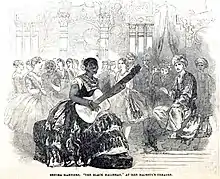Donna Maria Martinez
Donna Maria Martinez was a Cuban guitarist and singer who was active in Spain, France, and the United Kingdom in the mid 19th-century. Originating in Cuba, she moved to Seville and studied at the Madrid Royal Conservatory. She performed to prominent audiences in Paris and latterly London, at Her Majesty's Theatre, which attracted significant press coverage.

Early life and family
Martinez was born in Havana. Her father was a wood carver. Her musical abilities were recognised at a young age and she became part of the family of the Intendente of Havana, Don Francisco Aguilar, and was educated with his daughters.
Aguilar and his family returned to their native Spain, and Martinez accompanied them, settling in Seville. Martinez married Don Mariano Morena, a Cuban army officer, but the couple were later forced to leave Cuba after falling foul of the Cuban authorities.
Career
Martinez returned to Seville and taught guitar to pay for her entry to the Madrid Royal Conservatory. Martinez impressed Queen Isabella II of Spain and received a pension from her. Martinez subsequently performed in Paris to great success.[2]
July 1850 performances at Her Majesty's Theatre, London
In July 1850 Martinez appeared in a divertissement at Her Majesty's Theatre in London called Les Delices du Serail, set in a seraglio. After the curtain came up, a Sultan was shown amused by the dances of odalisques. Martinez then appeared "attired in a suit of rich amber-coloured satin" and performed.[3] Her debut appearance at the theatre had been twice delayed by the closure of the theatre as a result of the death of Prince Adolphus, Duke of Cambridge, and her vocal hoarseness.[2] The Times wrote that "the expectations of the public...were not a little wound up".[3]
In London Martinez was marketed as the 'Black Malibran', in reference to the Spanish singer Maria Malibran. Edward Walford, writing in Old and New London (1878) wrote Martinez "sang quaint Spanish melodies". The opera manager Benjamin Lumley wrote in his History of the Opera, that Martinez's songs were "full of original charm, her execution excellent, her voice sweet, pure, and true; but the whole performance was small almost to meagreness, and, although it might well be regarded as a piquant musical curiosity, it failed in any real power of attraction".[4] The Illustrated London News described her voice as "wild, quaint and graceful" with its "dominant qualities" of "picturesqueness and its strong and unanticipated contrasts" and described her vocal quality as "sweet and luscious".[2] The Times wrote that her singing was "quaint and pointed, especially when she seems to give vent to a flow of spirits".The Times wrote that "much applause" followed each song, but concluded that "enough disapprobation was mingled with approval to render it pretty certain the Cuban style of vocalisation will not get a permanent foothold in this country".[3]
Martinez's race was frequently commented on in contemporary accounts.The Illustrated London News wrote that "the fame of this lady had reached us and as a mark of social progress in the 'black race' was to us fraught with peculiar interest".[2] The Times wrote that the appearance in one of the boxes of Her Majesty's Theatre of "a lady of colour has caused much conversation in the lobbies".[3] Later 19th century accounts of her used racist language. In a chapter entitled "The Desecration of the Stage" in the periodical Time, an anonymous writer wrote that "the idea of nigger minstrelsy had not yet suggested itself" before Martinez was introduced to the "English opera goer" after a "great flourish of trumpets" and lamented the contemporaneous appearance of the Mastadon Minstrels.[5]
References
- The Illustrated London News, 20 July 1850.
- "Illustrated London News, 20 July 1850, p. [53]". Illustrated London News. 20 July 1850. Retrieved 7 January 2020.
- "Her Majesty's Theatre". The Times (20542). 16 July 1850. Retrieved 8 January 2020.
- "Survey of London - Old and New London Old and New London: Volume 4 Waterloo Place and Her Majesty's Theatre". Survey of London: Volume 4 Waterloo Place and Her Majesty's Theatre. British History Online. Retrieved 7 January 2020.
- Time. Kelly. 1880. p. 663.